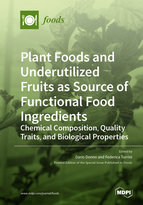Plant Foods and Underutilized Fruits as Source of Functional Food Ingredients: Chemical Composition, Quality Traits, and Biological Properties
A special issue of Foods (ISSN 2304-8158). This special issue belongs to the section "Food Nutrition".
Deadline for manuscript submissions: closed (30 September 2018) | Viewed by 42025
Special Issue Editors
Interests: plant foods; agrifood application and its nutritional properties; analytical strategies for phytochemical and nutritional characterization
Special Issues, Collections and Topics in MDPI journals
Interests: green extraction; ultrasound; waste management; circular economy; food chemistry; dietary food supplements; functional foods
Special Issues, Collections and Topics in MDPI journals
Special Issue Information
Dear Colleagues,
Changes in lifestyle and demographics, rising consumer incomes, and shifting preferences due to advanced knowledge about the relationships between food and health, contribute to generate new needs in food supply. Today, the role of food is not only intended as hunger satisfaction and nutrient supplying, but also as an opportunity to prevent nutrition-related diseases and improve physical and mental well-being. For this reason, there is a growing interest in novel or less well-known plant foods that offer an opportunity for health maintenance. Recently, interest in plant foods and underutilized fruits is ever more growing and agrobiodiversity exploitation offers effective and extraordinary potentialities. Plant foods could be an important source of health-promoting compounds and functional food ingredients with benefical properties: the description of quality and physico-chemical traits, the identification and quantification of bioactive compounds, and the evaluation of their biological activities are important to assess plant food efficacy as functional foods or source of food supplement ingredients.
Dr. Dario Donno
Dr. Federica Turrini
Guest Editors
Manuscript Submission Information
Manuscripts should be submitted online at www.mdpi.com by registering and logging in to this website. Once you are registered, click here to go to the submission form. Manuscripts can be submitted until the deadline. All submissions that pass pre-check are peer-reviewed. Accepted papers will be published continuously in the journal (as soon as accepted) and will be listed together on the special issue website. Research articles, review articles as well as short communications are invited. For planned papers, a title and short abstract (about 100 words) can be sent to the Editorial Office for announcement on this website.
Submitted manuscripts should not have been published previously, nor be under consideration for publication elsewhere (except conference proceedings papers). All manuscripts are thoroughly refereed through a single-blind peer-review process. A guide for authors and other relevant information for submission of manuscripts is available on the Instructions for Authors page. Foods is an international peer-reviewed open access semimonthly journal published by MDPI.
Please visit the Instructions for Authors page before submitting a manuscript. The Article Processing Charge (APC) for publication in this open access journal is 2900 CHF (Swiss Francs). Submitted papers should be well formatted and use good English. Authors may use MDPI's English editing service prior to publication or during author revisions.
Keywords
-
natural plant foods
-
healthy properties
-
phytochemicals
-
agrobiodiversity
-
human nutrition
-
analytical strategies
-
bioactivity
-
unconventional fruits
-
in vitro test
-
natural antioxidants








